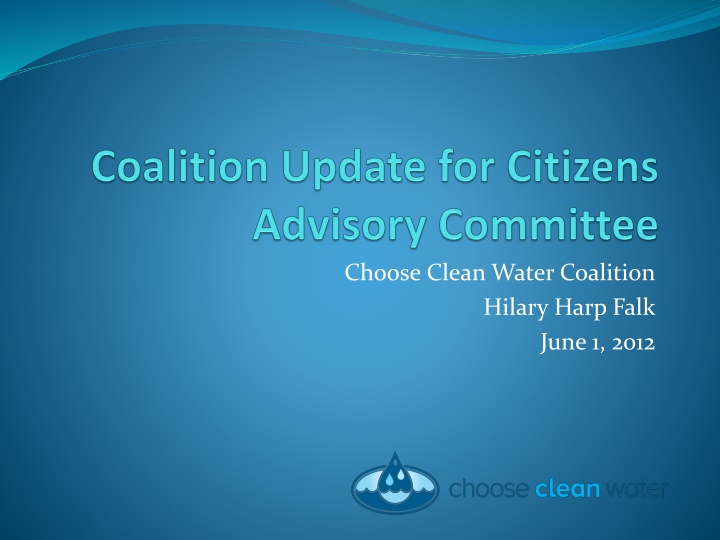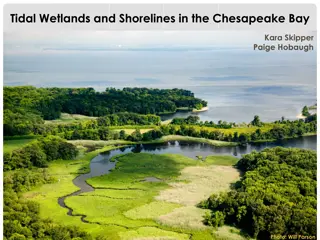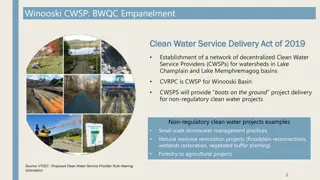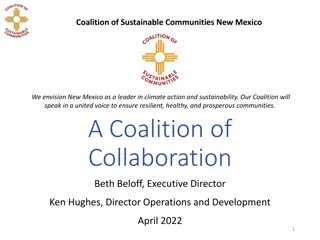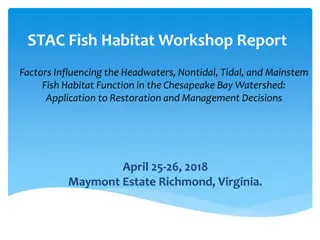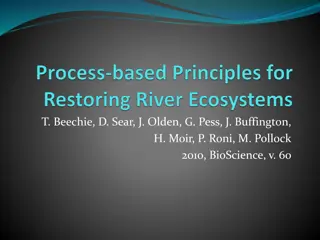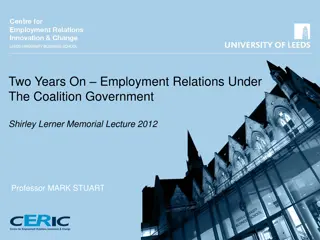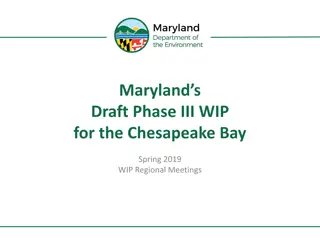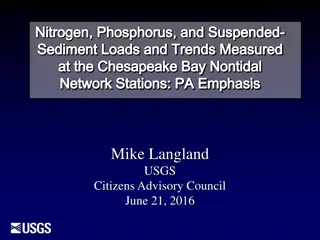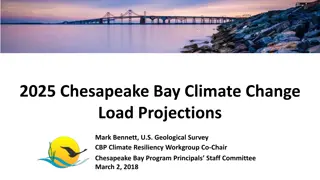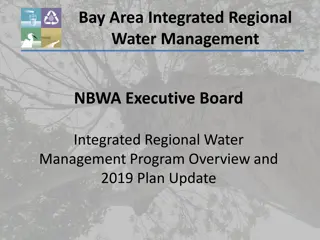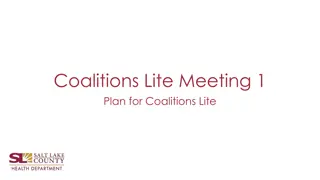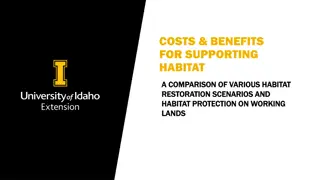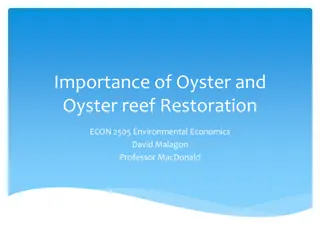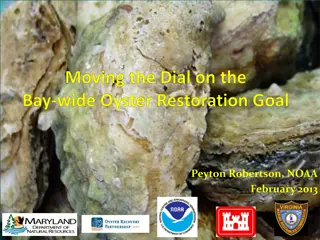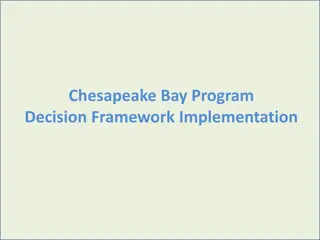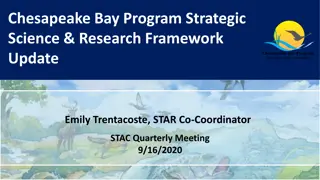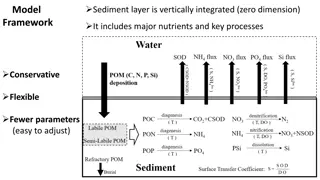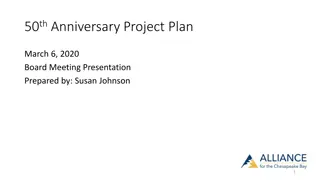Coalition for Clean Water: Advocating for Chesapeake Bay Restoration
The Choose Clean Water Coalition, led by Hilary Harp Falk, is a diverse group of over 230 organizations working towards restoring rivers and streams in the Chesapeake region. Their mission includes coordinating policies and actions at all levels to ensure clean-up success. With a vision of vibrant, clean water bodies in the area, the coalition's priorities for 2012 focus on pollution diet implementation, runoff prevention in urban areas, and defending against threats to restoration efforts. They aim to address challenges such as weak watershed plans, legal obstacles, and reduced resources for implementation.
Download Presentation

Please find below an Image/Link to download the presentation.
The content on the website is provided AS IS for your information and personal use only. It may not be sold, licensed, or shared on other websites without obtaining consent from the author.If you encounter any issues during the download, it is possible that the publisher has removed the file from their server.
You are allowed to download the files provided on this website for personal or commercial use, subject to the condition that they are used lawfully. All files are the property of their respective owners.
The content on the website is provided AS IS for your information and personal use only. It may not be sold, licensed, or shared on other websites without obtaining consent from the author.
E N D
Presentation Transcript
Choose Clean Water Coalition Hilary Harp Falk June 1, 2012
Coalition Membership is as Diverse as the Region We Serve We re more than 230 organizations national to regional to the most local of levels located throughout our six states and DC. Our groups include: Conservation, Restoration, Water Monitoring, Sportsmen, Environmental, Faith-Based, Planning, Economic Development, Land Trusts
Our Steering Committee National Parks Conservation Association Natural Resources Defense Council National Wildlife Federation Piedmont Environmental Council PennFuture Potomac Conservancy Virginia Conservation Network West Virginia Rivers Coalition Anacostia Watershed Society Audubon Naturalist Society Chesapeake Bay Foundation Clean Water Action Delaware Nature Society Environment Maryland James River Association National Aquarium of Baltimore
Our Vision for the Future Vibrant, clean rivers and streams in all communities in the Chesapeake region.
Coalition Mission To serve as a strong, united, effective advocate for restoring the thousands of streams and rivers flowing to the Chesapeake Bay by coordinating policy, message, actions and accountability for clean-up success at the federal, state and local levels.
CCWC 2012 Priorities Ensuring effective implementation of the Chesapeake Bay watershed-wide pollution diet Improving policies that stop polluted runoff in urban areas Protecting communities from water pollution created by gas drilling Defending against Congressional or Administration attempts to weaken or eliminate attempts to weaken efforts for Chesapeake Bay watershed restoration and protection
Threats to Chesapeake Bay Clean-up Weak watershed implementation plans Legal threats that would stop or delay implementation of the pollution diet Reduction in financial resources for WIP implementation Congressional attacks on the Clean Water Act and pollution diet
What Will Work Local waters messaging Collaboration Building infrastructure in key Congressional districts Success stories Benefits of pollution diet implementation
Water Is A Local Issue Strong messaging can build support for the implementation of the pollution diet and defend against threats to weaken efforts for restoration and protection.
Make the Pollution Diet Local Our local waters. Be specific: name rivers and streams. Our health. Talk about the sources of our drinking water. Talk about being able to eat the fish, safely swim. Our economy. The tourism, fishing and recreational industries are vital to local economies. Our local needs. Each locality has an opportunity this year to decide how we will clean up and protect our waterways over the next twenty years. Our lands. How we use the land, what we build on it, and how we build, are decisions about what we re going to allow into our rivers and streams. Our responsibility. Everyone is responsible for the pollution they allow into the water, and for the impact that has on everyone else.
State Leads Virginia Virginia Conservation Network Maryland 1000 Friends of Maryland Pennsylvania PennFuture West Virginia West Virginia Rivers Coalition
Virginia Through direct engagement with localities in Virginia, Coalition member organizations we were able to help guide and focus the responses local government submitted to the state. The Communities for Clean Water workshops hosted by the Virginia Coalition for local government staff opened the door and allowed Coalition partners to continue to engage and support critical implementation efforts.
Virginia Conservation Concepts, our local government technical contractor in Virginia, facilitated the George Washington Planning District submission, and through our conference calls, shared many of the strategies with other Coalition members working with localities. Through his involvement, the Shenandoah Riverkeeper was able to positively influence Rockingham County s submission. This significantly altered their tone from a negative one that attacked the pollution diet, into a positive and valuable tool we will be able to use in advocating for funding agriculture best practices.
Virginia By the end of February 2012 when the local information was due to the state, the tide had turned and participation in the process gained momentum. Only 5% of localities did not respond at all, and 75% responded with clear strategies to implement reductions in their region.
Maryland Maryland Coalition members released 24 barometers, one for each county and Baltimore City. These public-friendly documents rated the quality of local plans and identified next steps. The barometers received significant local press coverage and resulted in local partners across the state being contacted and invited to join the WIP team. This was most striking in Wicomico County, where the county team had been closed to outside participants.
Maryland Coalition members generated roughly 1,300 standard comments as well as more technical comment letters from coalition partners. Coalition letter had 36 coalition members sign on, including groups that had previously not engaged in the issue. Effort showed broad public support for the WIP, empowering Maryland s Department of the Environment to defend the plan and the process. It also clearly showed the state that there are critical deficiencies in their plan, starting an important dialogue on reform.
Pennsylvania Coordinated a sign-on letter to Governor highlighting the importance of the Phase II WIP and the critical components. Coordinated a sign-on letter encouraging each of PA s counties within the Bay watershed to work to submit local plans for the Phase II WIP and attend the upcoming DEP meeting about the process. Letter highlighted community success stories. This communication helped to raise awareness at the local government level about the Phase II WIP process and reinforce the importance of the upcoming DEP meeting to discuss county-level plans, local efforts and program gaps.
Delaware Comments submitted to Delaware s Department of Natural Resources and Environmental Control which provided recommendations, questions, and comments to the state plan. These questions and recommendations were addressed and incorporated into the final Plan. Chesapeake Bay Outreach Coordinator put together a presentation focused on the importance of Choosing Clean Water. Presentations to town councils, master gardener clubs, 4H leaders, and service groups in the state using a conversational approach and local waters frame, provided much needed grassroots understanding of the pollution diet s role in protecting Delaware s waters.
West Virginia West Virginia River Coalition s goal was submission of a stronger Phase Two Plan by the state and a greater level of local engagement in the planning and submission process.
Federal Policy Executive branch ensure that the president s annual budget contains the proposed funding needed to keep the restoration effort on track. Legislative branch protect the Clean Water Act budget and partisan politics will target Chesapeake restoration funds and programs especially the regulatory approach through the EPA s efforts with the Bay pollution diet.
Coordinating Federal Policy Overcoming Congressional Attacks Appropriations "rider" offered by Congressman Bob Goodlatte in February 2011 to stop EPA from spending any money on the TMDL H.R. 4153 was introduced by Bob Goodlatte (R-VA) and Tim Holden (D-PA) to amend the Clean Water Act to specifically take away EPA's ability to develop and implement an enforceable TMDL for the Chesapeake Bay watershed.
Coordinating Federal Policy Overcoming Congressional Attacks Appropriations "rider" offered by Congressman Bob Goodlatte in February 2011 to stop EPA from spending any money on the TMDL H.R. 4153 was introduced by Bob Goodlatte (R-VA) and Tim Holden (D-PA) to amend the Clean Water Act to specifically take away EPA's ability to develop and implement an enforceable TMDL for the Chesapeake Bay watershed.
Farm Bill 2012? Senate Marked up in April, Regional Conservation Partnership with priority areas House Mark-up a bill on June 19, not looking good Crystal ball Unlikely by September 30th (but could happen in lame duck ) likely to depend on the election Best case scenario extension!
Federal Policy - Appropriations Program Enacted for FY2012 President Request FY2013 Coalition s Request House Senate Final FY 2013 EPA Chesapeake Bay Program $57.371 million $72.371 million $72.371 million Clean Water SRF (EPA) $1.4688 billion $1.175 billion $2.1 billion USDA EQIP $1.408 billion (estimate) $1.403 billion $1.403 billion USDA Chesapeake Bay Watershed Initiative (2008 Farm Bill) $50 million $50 million $50 million USDA Forest Service- Chesapeake Forests $0.9 million $0.9 million $0.9 million USGS Chesapeake Bay Studies $7.63 million $9.849 million $9.849 million NPS Chesapeake Regional programs $2.981 million $3.005 million $3.005 million Chesapeake Bay Activities (FWS) $3.5 million $3.5 million Interagency Initiative: (Interagency R&D Initiative on Hydraulic Fracturing) A. U.S. EPA $14 million $14 million A. U.S.G.S. $19 million $19 million A. Dept. of Energy $12 million $12 million $10 million $12 million
Coalition Staff Hilary Harp Falk, Program Director email: falkh@nwf.org phone: 443-759-3406 Deb Kleiner, Communications Manager NEW: Tanya Dierolf, Field Manager Peter Marx, Federal Affairs
